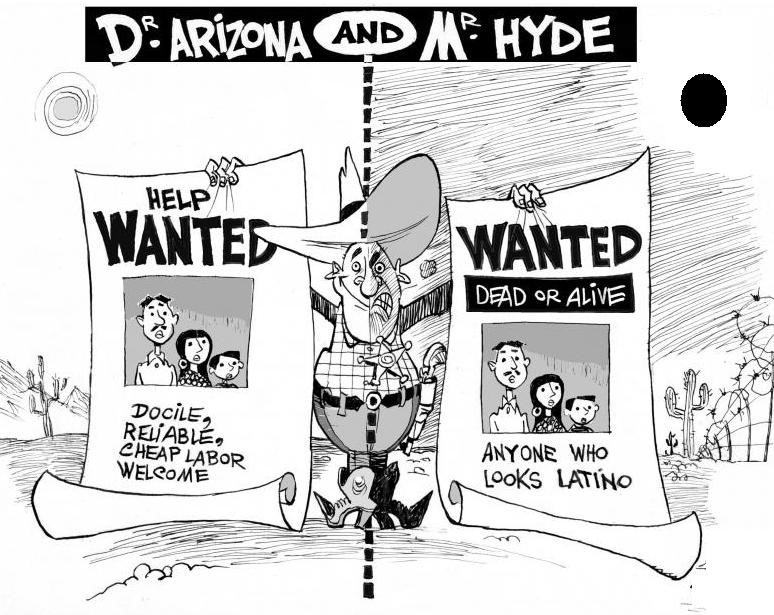Date Developed: 8/01/14
Guiding Historical Question: Why does the term "E Pluribus Unum" contradict itself?

Title: Charles Todd at the recording machine surrounded by a group of Mexican boys and men
Date: 1941
Collection: Charles L. Todd and Robert Sonkin Migrant Workers Collection (AFC 1985/001)

Date: 1941 Collection: Charles L. Todd and Robert Sonkin Migrant Workers
Collection: (AFC 1985/001)

Title: Mexican American Song
Date: 2014
Collection: Library of Congress

Title: HB 2281 House Bill
Date: 2010
Collection: State of Arizona House of Representatives Forty-ninth Legislature

Title: Senate Bill 1070
Date: 2010
Collection: State of Arizona Senate Forty-ninth Legislature

Title: H.R.4918 - Bracero Justice Act
Date: 2002
Collection: Library of Congress

Title: United States and Mexico: Immigration Policy and the Bilateral Relationship
Date: 2004
Collection: Library of Congress

Title: Guest Worker Programs: Mexico
Date: 2014
Collection: Library of Congress

Title: Close to Slavery: Guest worker Programs in the United States
Date: 2013
Collection: Southern Poverty Law Center
1940 The United States has more than a half-century’s experience in dealing with guest-worker programs, dating back to the World War II-era Bracero Program that allowed Mexican laborers to come here and work on the nation’s farms and railroads.
Bracero Program- Perhaps the most controversial U.S. guest-worker initiative was the Bracero Program that ran from 1942 to 1964. Drawing its name from the Spanish word for “strong-arm,” the Bracero Program brought millions of Mexican workers into the country to compensate for the labor shortages during World War II.
The program was poorly run and poorly regulated. Workers were often exploited and forced to endure shameful conditions. Many simply abandoned the program, migrated to the cities, and became part of the first wave of post-war illegal immigration.
The abuses of Braceros were inspiration for a number of folk artists and protest singers during the period, including Woody Guthrie and Phil Ochs. Mexican-American labor leader and civil rights activist Cesar Chavez started his historic movement for reform in response to the abuses suffered by the Braceros.
Critics of guest-worker programs argue that it’s virtually impossible to run them without widespread worker abuses. They contend that the programs are inherently given to exploitation and creating an under-class of servile workers, tantamount to legalized slavery.
Simply put, a guest-worker program allows a foreign worker to enter the country for a specified period of time and fill a specific job. Industries with surges in labor needs such as agriculture and tourism often have hired guest workers to fill seasonal positions.
Curriculum-In 2010 a court upheld most provisions of an Arizona state law (HB 2281) used to prohibit a controversial Mexican-American Studies curriculum in Tucson. Arizona state law HB 2281 is designed to prevent diverse views among minority groups, citing that such views can be harmful to the united view that the conservative leadership in Arizonian propagates. This case also resulted in the teachers who develop the curriculum being fired from the school district for violating Arizona’s state law. Furthermore, Federal judge Wallace Tashima upheld HB 2281, citing that the state has the right to limit curriculum that they believe could encourage overthrowing the government.
Tom Horne, the designer of HB 2281, also advocates for a Western Civilization centered curriculum, with a strong focus in Greco-Roman history. Horne also made a priority of enforcement of Arizona’s voter-approved law mandating that English be the language of classroom instruction.
The experimental Tucson curriculum was offered to students in different forms in some of the local elementary, middle, and high schools. It emphasized critical thinking and focused on Mexican-American literature and perspectives.
SB 1070- U.S. federal law requires an immigrant over the age of 14 who remains in the United States for longer than 30 days to register with the U.S. government and to have registration documents in their possession at all times; violation of this requirement is a federal misdemeanor crime.
The Arizona Act additionally made it a state misdemeanor crime for an immigrant to be in Arizona without carrying the required documents, required that state law enforcement officers attempt to determine an individual's immigration status during a "lawful stop, detention or arrest" or during a "lawful contact" not specific to any activity when there is reasonable suspicion that the individual is an illegal immigrant. The law barred state or local officials or agencies from restricting enforcement of federal immigration laws, and imposed penalties on those sheltering, hiring and transporting unregistered immigrants. Protests were held by a number of professional sports organizations. The Supreme Court struck down most of the law, citing that many of the facets of the law already existed at the federal level.
